Getting rid of scar tissue
Scar tissue can become very restrictive if you leave it untreated. But the scars we are referring to here are not the external type. When you injure muscles, ligaments, and tendons you almost invariably create scarring as part of the healing process. These scars are the internal type. The type that can hamper your movement and cause further injury.
But what is scar tissue exactly – and why is it so important to get it sorted out?
What is scar tissue?
After you suffer an injury, it would be great if the damaged soft tissue just regenerated and replaced the damaged or torn tissue. Unfortunately, this is not the case.
After trauma (however mild) the body produces extra collagen to add strength to the weakened tissue of the injury. The Greek origin of the word collagen means ‘glue-producing’ and it is the body’s clever way of sticking you back together again.
However, if excess collagen is produced then scar tissue can begin to build up around the site of the injury. It is not as supple or flexible as the original tissue. If it is allowed to build up without treatment, it can begin to irritate and inflame the surrounding area.
How can scar tissue be treated?
Scar tissue should be treated as early as possible. The longer you leave it the more problematic it can get. It is like not cleaning a paintbrush after you have used it. Unless you clean and straighten out the bristles in the early stages, the paintbrush will be stiff and inflexible next time you come to use it.
It is the same with your muscles and scar tissue. The more quickly you take care of them, the more quickly they can be re-used.
Ultrasound
It can certainly help to reduce the scar tissue in the early stages. It’s a well-established treatment that has been around since the 1940s.
It involves the use of a round-headed wand (probe) that is put in direct contact with your skin. It produces a wave that vibrates at about 0.8 to 1.0 Mhz. This wave can pass through the skin, and produces a vibration of the local tissue.
This form of treatment has been shown to stimulate blood flow, help to relax muscles and start to break down scar tissue.
However, to fully break it down, it’s worth investing in some deep tissue massage. When applied properly, this will promote full and proper healing. If there are visible scars in your skin as well, you may seek treatment from a cosmetic dermatology specialist.
It helps to increase flexibility and range of movement in the affected area. This is instrumental in helping to prevent re-injury.
It is also helpful in relieving pain and nerve impingement. Which often means you will be able to return to light training more quickly.
The deep tissue massage is particularly effective because it helps break up the adhesions between the scar tissue and the surrounding muscles.
…. And once you have managed to break the scar tissue down. Remember to be thorough in your warm-up and stretching so that you can avoid any future recurrence of the injury!
We hope this information is useful for you. If you have any questions about our treatments, please contact us. You can find us in Islington and Mill Hill Broadway. If you like this blog, please share!
We are always happy to help.



